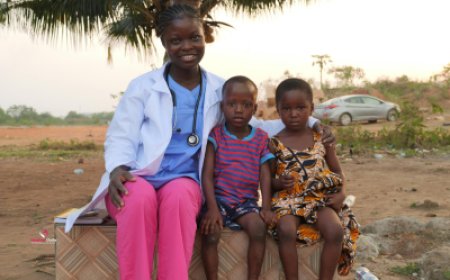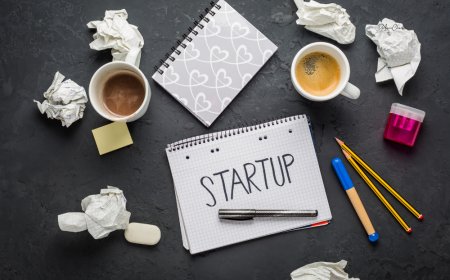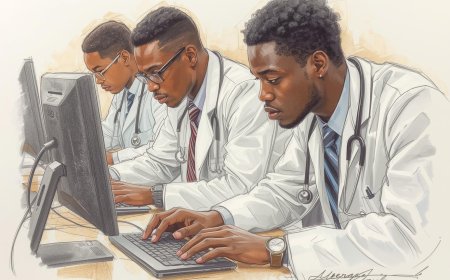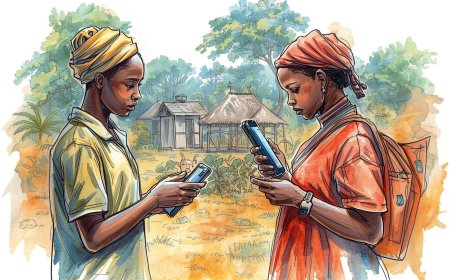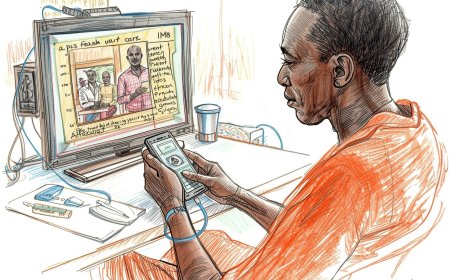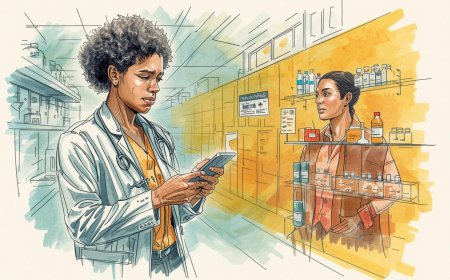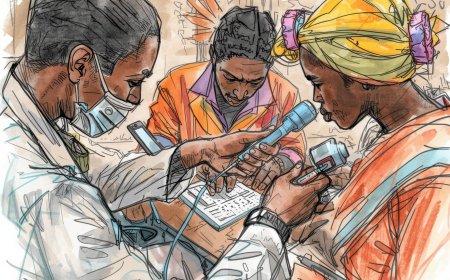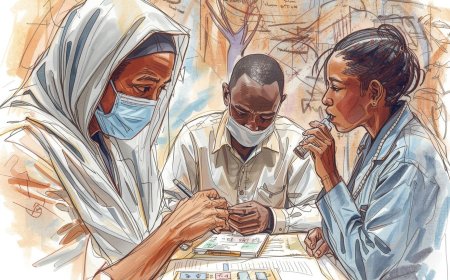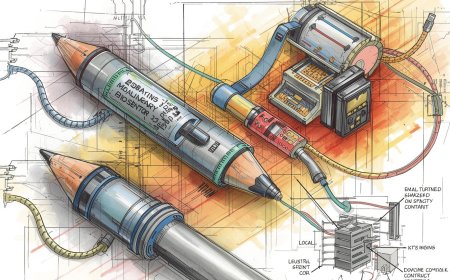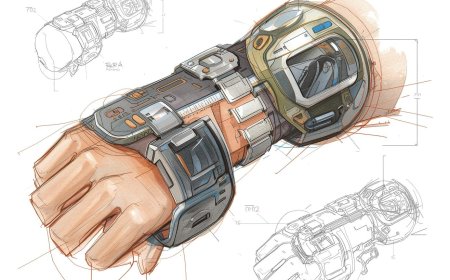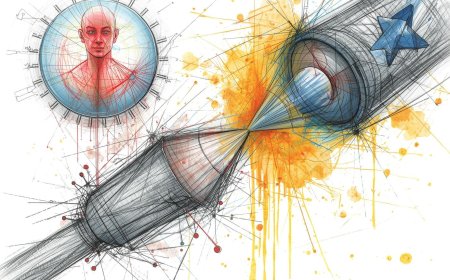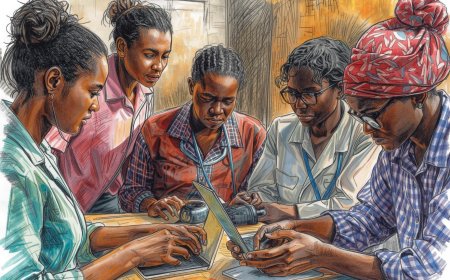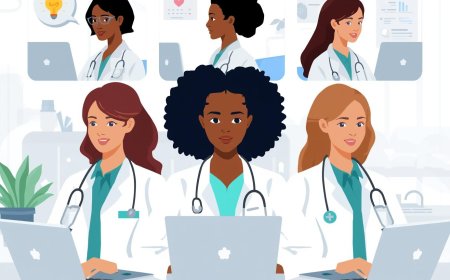The African Healthtech Pitch: A 10-Slide Blueprint for Securing Investment
A comprehensive guide for entrepreneurs on how to create a winning 10-slide healthtech pitch deck tailored specifically for an African audience. This article provides a step-by-step breakdown of each slide, incorporating case studies from successful African startups like Helium Health, mPharma, and 54gene. It offers insights into framing the problem, solution, and market opportunity to resonate with investors focused on the African continent, and details what VCs and angel investors are looking for in the current funding climate.

Introduction: The $259 Billion Opportunity – Framing the African Healthtech Narrative
The narrative surrounding healthcare in Africa is often dominated by its challenges: underfunded systems, critical infrastructure gaps, and a severe shortage of human capital.1 While these realities are undeniable, they represent only one side of the story. For astute entrepreneurs and investors, these systemic gaps constitute the continent's most significant and scalable investment opportunities. The African healthcare and wellness market is projected to reach a value of US$259 billion by 2030, making it a formidable engine for economic growth.3 The digital health segment, in particular, is experiencing explosive expansion, valued at USD 3.8 billion in 2023 and forecast to grow at a compound annual growth rate (CAGR) of 23.4% to reach USD 16.6 billion by 2030.4 This trajectory is powered by substantial capital infusions, with the sector attracting $550 million between 2020 and 2023 and demonstrating unique resilience during the broader venture capital downturn of 2023.3
However, securing a portion of this capital requires a narrative that transcends incremental improvement. The most successful healthtech pitches are not about digitizing broken legacy systems; they are about architecting entirely new ones. The continent's history of technological adoption is defined by "leapfrogging"—bypassing outdated infrastructure in favor of modern, more efficient solutions, as seen in the transition from landlines directly to mobile phones.6 With a mobile penetration rate of 44% in Sub-Saharan Africa and rapidly expanding internet access, mobile-first technology now provides the fundamental rails for the next generation of healthcare infrastructure.5
Therefore, a pitch deck that converts is one that frames the venture not as a feature or an app, but as a foundational platform. The compelling story for investors is not "we are building a better EMR for African hospitals," but rather, "we are building the digital infrastructure for Africa's healthcare system from the ground up." This positions the startup as an indispensable utility with a vast addressable market and a powerful, defensible moat. This report provides a strategic blueprint for constructing such a pitch, deconstructing the classic 10-slide model and adapting each component to the specific realities, data, and investor expectations of the African healthtech ecosystem.
Part I: The Anatomy of a Winning 10-Slide Deck for Africa
A successful pitch deck is a masterclass in concise, compelling communication. While frameworks like Guy Kawasaki's 10/20/30 rule provide a solid foundation—10 slides, 20 minutes, 30-point font—their application must be meticulously tailored to the target audience.9 For an African healthtech venture, this means each slide must not only present a core business concept but also demonstrate a profound understanding of the local context, preemptively address investor concerns about the market, and build a case for a scalable, Africa-first solution.
Slide 1: The Title – Your One-Sentence Mission for Africa
The title slide is the first impression, setting the tone for the entire presentation. Global best practice dictates a clean, professional layout including the company name, a concise tagline, and the presenter's contact details.10 For an African context, the tagline carries immense weight. It must transcend generic industry jargon and function as a bold, declarative mission statement that immediately signals deep market insight.14
Consider the contrast for a company like Helium Health. A generic tagline such as "A Digital Health Platform for Emerging Markets" is forgettable and fails to convey ambition or specificity. A far more powerful statement, reflective of their actual mission, would be: "Building the Digital Infrastructure for Africa's Healthcare System".16 This tagline is specific, signals a foundational and scalable vision, and speaks the language of platform-level innovation that sophisticated investors seek. It immediately frames the company as a builder of essential utilities, not just a purveyor of software. Investor red flags on this slide include vague mission statements that could apply to any geography or overly technical descriptions that obscure the core value proposition.
Slide 2: The Problem – Quantifying the Continent's Most Pressing Healthcare Gaps
This slide must create a powerful sense of urgency by defining the pain point your venture solves.19 For an African audience, this requires moving beyond broad generalizations about "poor healthcare" and presenting hyper-specific, quantifiable data that demonstrates deep local knowledge. The problem presented must also serve as the logical and inevitable setup for the solution that follows. A founder who presents a solution for telemedicine must frame the problem around the human capital crisis and geographic inaccessibility, not pharmaceutical supply chain issues. This narrative discipline demonstrates strategic clarity to investors, who are constantly pattern-matching a stated problem to a proposed solution.
A compelling problem slide for Africa should be built around one of these core, data-backed pillars:
-
The Human Capital Crisis: Africa bears 25% of the world's disease burden but is home to only 3% of its healthcare workers.1 This is not just a statistic; it is the root cause of systemic inaccessibility and inefficiency. Citing specific doctor-to-patient ratios, such as Nigeria's 0.4 physicians per 1,000 people—far below the WHO-prescribed ratio—makes the problem tangible and acute.2
-
Crushing Financial Barriers: With approximately 490 million people in Africa living below the poverty line and healthcare systems characterized by high rates of out-of-pocket expenditure, affordability is a primary barrier to care.4 Framing the problem in economic terms immediately highlights the need for fintech-enabled health solutions that can innovate on payments and access.
-
Fragmented Infrastructure & Leaky Supply Chains: The continent imports an estimated 94% of its pharmaceuticals, creating a complex and inefficient supply chain plagued by high costs, stockouts, and a dangerous counterfeit market.1 This specific, systemic failure is the core problem that a company like mPharma was built to solve.
-
The Double Disease Burden: African healthcare systems are uniquely strained by the need to combat infectious diseases like malaria and HIV/AIDS while simultaneously facing a rapid increase in non-communicable diseases (NCDs) such as diabetes and hypertension, which now account for over 37% of deaths in sub-Saharan Africa.1
The gold standard for a problem slide was set by 54gene. Their pitch was built on a stark, globally relevant data point: less than 3% of genomic data used in pharmaceutical research comes from African populations, despite the continent possessing the most genetically diverse genome on Earth.22 This single statement simultaneously established a massive scientific gap, a clear moral imperative, and an untapped commercial market of immense value.
Slide 3: The Solution – Demonstrating Your "Leapfrog" Innovation
Following a well-defined problem, the solution slide must present a value proposition that is unique, compelling, and, crucially, built for Africa's specific operational realities.10 This is the moment to proactively address an investor's unstated questions about execution in a challenging environment. The most convincing solutions are framed as "leapfrog" innovations that bypass, rather than depend on, failing legacy infrastructure.
Key characteristics of a strong, Africa-centric solution include:
-
Offline-First Capability: In a continent with uneven and often unreliable internet connectivity, a digital tool that requires constant connection is not a viable solution.25 Helium Health's explicit design of its Electronic Medical Record (EMR) system to be "offline first" is not a minor feature; it is a fundamental design principle that demonstrates a deep understanding of the market's constraints.18
-
Asset-Light and Scalable Models: Business models that do not require massive capital expenditure on physical infrastructure are inherently more scalable and attractive to venture investors. mPharma's model is a prime example. Instead of building its own chain of pharmacies, it partners with existing ones, providing a layer of technology for inventory management and demand aggregation.27 This asset-light approach allowed for rapid, cross-continental expansion.
-
Seamless Fintech Integration: Given the maturity and widespread adoption of mobile money and fintech platforms across Africa, a healthtech solution that fails to integrate with these payment rails appears disconnected from the ecosystem.5 Demonstrating native integration with services like M-Pesa or offering embedded payment solutions, like Helium Health's HeliumWallet, shows an understanding of how commerce and daily life are conducted.26
mPharma's solution slide would not simply present "an app for pharmacies." It would detail a multi-faceted platform offering innovative financing and inventory management. The core of the solution is using technology to aggregate demand across its network, which in turn gives it the bargaining power to negotiate lower prices from manufacturers. This value is then passed on to patients through its "Mutti" program, a financing scheme that allows for micropayments for medication—a direct and elegant solution to the problem of high, upfront out-of-pocket costs.28
Slide 4: The "Why Now?" – Capturing the Unique Confluence of Technology, Policy, and Need
This slide answers a critical question for investors: Why has this solution not been built before, and why is this the perfect moment for it to succeed?.14 A generic answer focused on global trends like the rise of AI is insufficient. The "Why Now?" for Africa must be a compelling narrative that weaves together a confluence of specific, local and regional catalysts.
An effective "Why Now?" slide should synthesize these key factors:
-
Technological Readiness: The primary enabler is the unprecedented proliferation of mobile technology. High mobile penetration and steadily decreasing internet costs have, for the first time, created a continent-wide infrastructure for delivering health services at scale.4
-
Policy and Government Tailwinds: There is a growing political will to improve healthcare outcomes. Founders should point to national strategic goals, such as commitments to Universal Health Coverage, and the rise of public-private partnerships. The existence of nearly 50 partnerships between startups and governments in the health supply chain alone is a powerful proof point that governments are now viewing startups as critical allies.3
-
Behavioral Shifts Accelerated by the Pandemic: The COVID-19 crisis acted as a massive catalyst for digital health adoption. In Nigeria, for example, the use of telemedicine services increased by over 50% during the pandemic.26 This was not a temporary blip but a fundamental and permanent shift in the behavior of both patients and providers, creating market acceptance that did not exist five years ago.
-
Maturation of the Investment Ecosystem: A decade ago, there were few, if any, venture capital funds dedicated to African healthtech. Today, a robust ecosystem of local and international investors, from incubators and angel networks to sector-specific VCs, is actively deploying capital into the space.32 This means that for the first time, there is a clear funding ladder for promising companies to climb.
Slide 5: Market Opportunity – Sizing the Addressable Market in a Data-Scarce Environment
Every pitch deck must quantify the market opportunity, typically using the TAM, SAM, and SOM framework (Total Addressable Market, Serviceable Available Market, and Serviceable Obtainable Market).19 However, in many African markets, reliable, top-down government or industry data is often unavailable or outdated. Investors are aware of this limitation. Therefore, a founder's credibility rests on their ability to construct a believable market size analysis from the bottom up.
A top-down statement like "The African healthcare market is a $259 billion opportunity" is a weak starting point. A much more convincing approach is to build the market size from specific, verifiable data points:
-
Adopt a Bottom-Up Methodology: Calculate the Serviceable Obtainable Market (SOM) by starting with tangible units. For a B2B SaaS company selling to clinics, the calculation would be: (Number of registered private clinics in Nigeria) x (Plausible market share in Year 3) x (Annual subscription fee) = Year 3 SOM. This demonstrates a granular understanding of the market.
-
Utilize Credible Proxies: In the absence of direct data, use strong, related data points. The number of mobile subscribers can be a proxy for the potential user base of a direct-to-consumer mHealth app.8 The number of registered doctors, nurses, or pharmacies can serve as a proxy for the size of the market for a professional-facing tool.
-
Acknowledge Market Fragmentation: Africa is a continent of 54 distinct countries, not a monolithic market.6 An effective market slide will present the opportunity on a country-by-country basis, focusing first on a launch market within the "Big Four" (Nigeria, Kenya, South Africa, Egypt), which collectively attract the vast majority of venture funding.38 This should be followed by a clear, phased plan for regional expansion.
Ultimately, the SOM is not just a number; it is a test of the credibility of the entire operating plan. An investor will mentally cross-reference the SOM with the go-to-market strategy and the financial projections. If a founder projects a $10 million SOM in three years but presents a vague go-to-market plan with a minimal marketing budget, the entire pitch loses credibility. A defensible, logically constructed SOM signals an operationally savvy founder who has a realistic plan for execution.
Slide 6: The Product & "Underlying Magic" – Showcasing Technology Built for African Realities
This slide is where the solution comes to life. The goal is to show, not just tell, what makes the product special.10 While global best practice emphasizes sleek UIs and demos, the "underlying magic" in the African context is often found in the product's elegant resilience and thoughtful adaptation to local constraints.
The product demonstration should highlight features that are uniquely valuable in Africa:
-
Simplicity and Usability: Showcase a user interface that is intuitive and designed for users who may have low computer literacy. Helium Health, for instance, incorporated elements from widely used social media platforms to make its EMR easy to adopt.18
-
Robustness and Reliability: Emphasize the technology's ability to function in challenging environments. This includes demonstrating offline-first capabilities or showing how the service can be accessed via basic SMS for users without consistent internet access, a strategy employed by companies like Zuri Health.5
-
Interoperability: In a highly fragmented healthcare ecosystem, a product that can connect disparate systems is immensely valuable. Show how the platform integrates with payment gateways, insurance providers, laboratories, or government health databases.
A company like Helium Health would not showcase just one product. Its "underlying magic" lies in its full-stack ecosystem. A powerful product slide would feature a unified dashboard demonstrating how data from HeliumOS (the EMR) flows to inform risk assessments for HeliumCredit (the lending arm), while transactions are seamlessly processed through HeliumWallet, and new patients are acquired via HeliumDoc.30 This visual representation of an integrated platform demonstrates powerful network effects and a data advantage that constitutes a deep, defensible moat.
Slide 7: The Business Model – Architecting Sustainable Revenue Streams
This slide must clearly and concisely explain how the business generates revenue.13 In the current investment climate, which has shifted significantly since the market peak of 2021-2022, models predicated on achieving massive scale before monetization are viewed with deep skepticism.40 Investors in Africa are looking for resilient business models with a clear and credible path to positive unit economics.
Successful models in African healthtech often exhibit the following characteristics:
-
Diversified Revenue Streams: Relying on a single source of income is risky. A more robust model combines multiple streams. Helium Health's model is an excellent example: it earns recurring SaaS fees from hospitals using HeliumOS, takes transaction fees from appointments booked through HeliumDoc and payments processed by HeliumWallet, and generates interest revenue from loans disbursed by HeliumCredit.30 This diversification creates a more stable and resilient business.
-
B2B2C Frameworks: Business-to-business-to-consumer models are particularly effective. A startup sells its platform to a healthcare provider (the business), which in turn uses the technology to deliver better, more efficient care to its patients (the consumer).42 This approach allows the startup to acquire customers more efficiently by targeting institutions rather than individuals, while still creating value for the end-user.
-
Context-Appropriate Pricing: The pricing strategy must be aligned with the economic realities of the target market. A high-priced subscription model may not be viable for small, independent clinics. mPharma's development of the "Mutti" micropayment plan for chronic medications is a brilliant pricing innovation, directly addressing the inability of many patients to afford a full month's supply of drugs at once.29
Business models that rely solely on advertising revenue, require enormous user volume before generating income, or cannot clearly articulate their unit economics are significant red flags for investors.
Slide 8: Go-to-Market & Traction – Proving Product-Market Fit with Early Wins
The traction slide provides the evidence that the business is not just a plan, but a living entity with market momentum.19 In Africa, this slide serves a dual purpose: it must demonstrate business growth while also systematically de-risking the perceived challenges of operating on the continent. International investors often carry implicit biases about political instability, regulatory hurdles, and corruption; the best traction slides use hard data to counter these fears directly.
Effective traction metrics for an African healthtech startup include:
-
Strategic Partnerships as Validation: A simple user growth chart is less compelling than a signed pilot project with a Ministry of Health or a major hospital group. These partnerships act as powerful third-party validation and de-risk the question of regulatory and market acceptance.3 mPharma's public-facing metrics of 155 hospital partners and 850 pharmacies are concrete, impressive proof of market penetration.28
-
Demonstrated Geographic Expansion: Showing successful operations in more than one country proves the business model is not a one-off success but a scalable playbook. Helium Health's methodical expansion from its base in Nigeria to Ghana, Kenya, and even the Middle East demonstrates this operational capability.17
-
Meaningful Operational Metrics: Instead of vague "vanity metrics" like app downloads, focus on metrics that reflect core business activity. For a pharmaceutical supply chain company, this could be "value of inventory managed." For a lending platform like HeliumCredit, stating that $5 million in loans have been disbursed is a hard metric that speaks to both scale and market trust.41 A strong loan repayment rate would further de-risk the financial model for investors.
Slide 9: The Competitive Landscape – Defining Your Unique Value Proposition
This slide demonstrates a startup's understanding of the market and its unique position within it.13 A common mistake founders make is to claim they have "no competitors," which signals to investors a lack of research or a non-existent market.13 Acknowledging competitors, even large ones, validates the market opportunity.
In the African context, the competitive landscape is often unique:
-
The Status Quo is the Main Competitor: For many healthtech startups, the primary competition is not another tech company but entrenched, inefficient, analog systems. This includes "pen and paper" for medical records, informal consultations via WhatsApp, or cash-based payments. The pitch should frame the startup's solution as a 10x improvement in efficiency, reliability, and data quality over these legacy methods.
-
Local vs. International Players: The competitive map should include both local startups and any global companies attempting to enter the market. The key is to articulate the local founder's inherent advantage: a deeper understanding of cultural nuances, user behavior, and the complex operational landscape.3
-
Use a Strategic Framework: A 2x2 matrix is a classic and effective tool. A company like Helium Health could use axes of "Technological Integration" (Low to High) and "Service Scope" (Point Solution to Full Stack). They would place "Pen & Paper Systems" in the bottom left, standalone EMR competitors in the bottom right, and themselves in the top right quadrant, visually defining their integrated ecosystem as their unique, defensible advantage.
Slide 10: The Team, The Ask, and The Vision
This final slide brings the entire pitch together, focusing on the three elements that ultimately drive an investment decision: the people, the plan, and the prize.15 For many investors, particularly at the early stage, this is the most important slide of all. They are betting on the team's ability to navigate the inevitable challenges of execution.
-
The Team: This section must establish "founder-market fit." Why is this specific team uniquely qualified to solve this problem in Africa? Highlighting direct experience with the problem is powerful. The story of Helium Health's founders taking a road trip across Nigeria to speak directly with hospital administrators before writing a single line of code is a compelling testament to their dedication and deep market research.17 The inclusion of advisors with strong local networks, regulatory expertise, or deep healthcare experience adds significant credibility.
-
The Ask and Use of Funds: The funding request must be specific and tied to clear milestones. A vague request "for working capital" is a red flag. A strong ask is broken down by function: "We are raising $1.5 million to be allocated as follows: 40% for market expansion into Kenya, including hiring a local team; 35% for engineering to build out our insurance module; and 25% for key hires in sales and operations".19 This demonstrates a clear, actionable operating plan.
-
The Vision: The presentation should end on an ambitious and inspiring note. The vision statement should connect the company's plan back to the massive opportunity outlined in the introduction. For example: "In five years, we will be the primary digital health infrastructure for 1,000 hospitals across East and West Africa, serving 5 million patients and facilitating $100 million in healthcare financing." The vision should feel like the logical and achievable culmination of the preceding nine slides.
Table 1: The 10-Slide Healthtech Deck: Africa-Specific Customization
|
Slide Number & Title |
Global Best Practice Objective |
The African Lens: Key Customization |
Data Points to Include (with Sources) |
Common Investor Red Flag |
|
1. Title |
Clean, professional first impression. |
State a bold, one-sentence mission for Africa. |
Company name, logo, contact info. |
Vague, generic tagline (e.g., "Improving Healthcare"). |
|
2. Problem |
Create urgency around a customer pain point. |
Quantify a specific, local healthcare gap (access, cost, infrastructure). |
Doctor-to-patient ratios 4, out-of-pocket expenditure stats 21, pharma import dependency (94%) 3, NCD burden.1 |
Broad statements about "poor healthcare in Africa." |
|
3. Solution |
Explain the value proposition and uniqueness. |
Emphasize features built for local realities: offline-first, asset-light, fintech integration. |
Screenshots/mockups showing simple UI, SMS capabilities, or mobile money integration.5 |
A solution that requires perfect internet connectivity or heavy infrastructure investment. |
|
4. Why Now? |
Explain why the market is ready for this solution. |
Connect macro trends (mobile penetration, policy shifts, investor interest) to the specific opportunity. |
Mobile penetration rates (44% in SSA) 7, post-COVID telemedicine adoption stats 26, recent government health initiatives. |
Relying only on global trends (e.g., "AI is improving") without local context. |
|
5. Market Opportunity |
Define market size with TAM, SAM, SOM. |
Use a credible, bottom-up SOM calculation due to data scarcity. Acknowledge fragmentation. |
Number of clinics/pharmacies in a launch market, average revenue per user, phased expansion plan for the "Big Four".38 |
A massive, top-down TAM without a believable, bottom-up SOM. |
|
6. Product / "Underlying Magic" |
Show, don't tell. Use visuals and demos. |
Highlight the "magic" in solving gritty, on-the-ground problems simply and robustly. |
Demo of offline functionality, flowchart of data interoperability, visual of a full-stack ecosystem. |
A complex product that appears difficult to deploy or use in low-resource settings. |
|
7. Business Model |
Explain how you make money sustainably. |
Show resilient, diversified revenue streams with clear unit economics. Pricing must fit the market. |
SaaS fees, transaction fees, interest from lending, B2B2C structures, pricing tiers for different market segments.30 |
A "growth at all costs" model with no clear path to profitability. |
|
8. Go-to-Market & Traction |
Provide evidence of product-market fit. |
Use traction to de-risk the "Africa" question. Focus on partnerships and operational metrics. |
Number of partner hospitals/pharmacies 28, value of loans disbursed 41, signed government MOUs.3 |
"Vanity metrics" like app downloads without engagement or revenue data. |
|
9. Competition |
Identify competitors and your unique advantage. |
Acknowledge the "status quo" (pen & paper, WhatsApp) as a key competitor. Emphasize local advantage. |
2x2 matrix comparing your solution against informal systems, local startups, and international players. |
Claiming "we have no competition." |
|
10. Team, Ask, & Vision |
Introduce the team, state the funding need, and inspire with a long-term vision. |
Emphasize founder-market fit and local expertise. Provide a detailed, milestone-based use of funds. |
Founder bios highlighting relevant African experience 17, a specific breakdown of the "Ask" 46, a 5-year vision statement. |
An inexperienced team with no local knowledge; a vague use of funds. |
Part II: Lessons from the Arena – In-Depth Case Studies of African Healthtech Pioneers
Analyzing the strategies of companies that have successfully raised significant capital in Africa provides an invaluable playbook for emerging founders. The journeys of Helium Health, mPharma, and 54gene, while distinct, offer critical lessons in business model design, market focus, and the challenges of scaling ambitious visions.
Helium Health: The Power of a Full-Stack Ecosystem
Helium Health's strategy is a masterclass in building a defensible business through vertical integration. The company did not begin with a grand plan to offer a full suite of services; it started by solving a core, tangible problem for Nigerian hospitals: the transition from paper-based records to a digital system.17 Its initial product, HeliumOS, was an EMR and hospital management platform designed specifically for the African context—robust, easy to use, and capable of working offline.18
However, this initial entry point was strategically used as a beachhead to understand the deeper, interconnected problems of its clients. By digitizing hospital operations, Helium Health gained unparalleled insight into their revenue cycles, patient flows, and financing gaps. This data became the foundation for its subsequent product launches, creating a powerful flywheel effect:
-
Data from HeliumOS revealed the immense financial constraints on healthcare providers. This led directly to the creation of HeliumCredit, a lending platform that could use the real-time operational data from the EMR to underwrite loans far more effectively than a traditional bank.30
-
Observing payment collection challenges led to the development of HeliumWallet, a digital payment system that simplified billing and improved revenue management for providers.30
-
To help its partner hospitals grow their patient base, the company launched HeliumDoc, a telemedicine and appointment booking platform that connected patients to the providers already using its network.30
This full-stack ecosystem is Helium Health's core competitive moat. A new competitor offering only an EMR cannot compete with a platform that also provides financing and patient acquisition channels. The data from one part of the business de-risks and enhances the others, creating a sticky, integrated system that is difficult for clients to leave and for competitors to replicate.
The lesson for founders is clear: Solving one critical problem exceptionally well can be the entry point to building a much larger, more defensible platform. The initial product should be designed not just for its own market, but as a data-gathering tool to identify and solve adjacent, high-value problems for the same customer base.
mPharma: The Art of a Hyper-Focused, High-Impact Model
In contrast to Helium Health's ecosystem approach, mPharma demonstrates the power of a hyper-focused, asset-light business model. mPharma identified a single, critical bottleneck in the African healthcare value chain: the pharmaceutical supply chain. The system was inefficient, fragmented, and resulted in high prices and frequent stockouts for patients.1
mPharma's genius was in its decision not to compete with existing pharmacies by building its own. Instead, it chose to partner with them, offering a technology layer that solved their biggest problems: inventory management and financing. The core of its business model is demand aggregation. By providing its software to a network of hundreds of pharmacies and hospitals across nine countries, mPharma gains a real-time view of demand for various medications.28 It then pools this demand and negotiates directly with pharmaceutical manufacturers, securing lower prices through bulk purchasing.
This capital-efficient, software-driven approach allowed for rapid and broad geographic scaling without the immense cost and complexity of building and managing a physical retail footprint.27 Furthermore, mPharma extended its focus to the end patient with its "Mutti" program. Recognizing that high upfront costs were a major barrier to access, Mutti allows patients with chronic illnesses to pay for their medication in installments, transforming a large, prohibitive expense into manageable micropayments.29 This was not just a financing product; it was a deep, empathetic solution to a core problem faced by millions.
The lesson for founders: It is not always necessary to build a sprawling ecosystem. A deep, technology-driven solution that relentlessly targets and solves a single, critical bottleneck in a large value chain can create a massive and highly impactful business. Capital efficiency and a focus on software over physical assets can be a powerful recipe for scalable growth in Africa.
54gene: Ambition, Innovation, and a Cautionary Tale
54gene's story is one of world-class vision and immense ambition. The company was founded on a powerful and undisputed premise: the African genome is the most diverse in the world, yet it is critically underrepresented in global research, accounting for less than 3% of the data used for drug discovery.22 By building a biobank and generating genomic data from African populations, 54gene aimed to unlock novel insights for drug development that would benefit both Africans and the global population.47
This vision was compelling enough to attract $45 million from top-tier international investors, including Y Combinator.22 The company successfully built a state-of-the-art lab in Nigeria, recruited over 100,000 research participants, and played a key role in Nigeria's COVID-19 testing response.23 Its business model was predicated on partnering with pharmaceutical companies to co-develop drugs based on its unique genomic insights.22
However, the company's journey also serves as a critical cautionary tale. The business model was inherently capital-intensive, requiring significant investment in laboratories, sequencing equipment, and large-scale data generation before it could generate substantial revenue from pharmaceutical partnerships. In 2022, the company faced significant challenges, including reports of dwindling revenue, layoffs, and a dramatic drop in valuation.49 The founder and CEO eventually resigned amidst allegations of financial mismanagement and a hostile takeover, and the company ultimately collapsed.49
The lesson for founders: A powerful vision is necessary, but not sufficient. When pitching a highly ambitious, capital-intensive model, founders must be prepared for intense scrutiny of their operational plan, capital efficiency, and corporate governance. The path from deep R&D to commercialization is long and fraught with risk. The pitch must not only sell the grand vision but also present a credible, phased plan for managing cash burn, achieving intermediate milestones, and maintaining strong governance, especially in a market where execution risk is already perceived as high.
Table 2: Comparative Analysis of Case Study Business Models
|
Company |
Core Problem Solved |
Business Model (B2B, B2C, etc.) |
Key Revenue Streams |
Scalability Strategy |
Core "Moat" / Defensibility |
|
Helium Health |
Fragmentation of hospital data, operations, financing, and patient access. |
B2B & B2B2C (Full-Stack Platform) |
SaaS fees (HeliumOS), Transaction fees (HeliumDoc, HeliumWallet), Interest on loans (HeliumCredit).30 |
Land-and-expand within facilities; methodical geographic expansion (Nigeria -> Ghana -> Kenya -> MENA).44 |
A deeply integrated, full-stack ecosystem with powerful network effects and a proprietary data advantage. |
|
mPharma |
Inefficient pharmaceutical supply chain leading to high drug prices and stockouts. |
B2B & B2C (Supply Chain & Financing Platform) |
Margin on drug procurement and distribution, fees for inventory management software, financing fees from "Mutti" program.29 |
Asset-light partnership model with existing pharmacies and hospitals, enabling rapid, low-cost expansion across 9 countries.28 |
Network scale and demand aggregation, giving it superior purchasing power and data on drug consumption patterns. |
|
54gene |
Underrepresentation of African genomic data in global drug discovery. |
B2B (Genomic Research & Development) |
Research partnerships with pharmaceutical companies, co-development of drug targets, molecular diagnostics.22 |
Building a proprietary, continent-wide biobank and sequencing lab to generate unique, high-value data assets.47 |
A unique and proprietary biobank of the world's most genetically diverse population. (Ultimately undermined by execution challenges). |
Part III: Decoding the Investor Mindset – What African VCs and Angels Truly Want
Securing investment is not just about having a great idea; it's about finding the right investment partner whose thesis, stage, and expectations align with the venture. The African healthtech investment landscape is maturing rapidly, but it has its own unique characteristics and players. Understanding their mindset is crucial for a successful fundraise.
The Investor Landscape
The ecosystem of capital providers for African healthtech is diverse, spanning from early-stage incubators to growth-stage private equity funds. Founders must tailor their pitch and their "Ask" to the specific investor type they are approaching.
-
Incubators and Accelerators (Pre-Seed/Seed): Players like Villgro Africa provide not just initial capital (often as grants or small equity checks) but also intensive, hands-on support in business model development, product-market fit, and network access.33 They are looking for strong, coachable teams with a compelling idea and an MVP.
-
Early-Stage Venture Capital (Seed/Pre-Series A): Firms like Jaza Rift Ventures and HealthCap Africa focus on early-stage funding, typically investing between $50,000 and $2 million.33 Their investment thesis is centered on backing technology-driven solutions with the potential for high scalability. They expect to see early traction, a clear business model, and a well-defined plan for using the capital to hit key growth milestones.
-
Growth-Stage Funds (Series A and beyond): Investors such as the Investment Funds for Health in Africa (IFHA) and LeapFrog Investments target more established companies with proven business models and significant revenue.33 They write larger checks ($5 million to $50 million) and focus on scaling operations across the continent. Their due diligence is intensely focused on unit economics, financial performance, and the strength of the management team.
-
Angel Networks and Syndicates: Groups like LoftyInc Capital Management and Angel Africa Ventures play a vital role in providing the earliest risk capital.35 These networks often consist of successful entrepreneurs and diaspora professionals who bring not only capital but also valuable mentorship and industry connections. They often invest using simpler instruments like SAFE notes to expedite deals.53
The Post-2022 Investment Thesis: The End of "Growth at All Costs"
The global venture capital market underwent a significant correction in 2022-2023, and Africa was not immune. The number of active investors on the continent dropped by 33% in 2023, marking a dramatic reversal of the previous years' trends.40 This "funding winter" triggered a fundamental shift in investor thesis, moving away from a "growth at all costs" mindset to a rigorous focus on fundamentals.
For founders, this means that financial projections and business models must reflect a new reality. The key metrics that investors now scrutinize more than ever include:
-
Capital Efficiency: How much growth can be generated for every dollar of capital burned? Models that require massive, sustained losses to achieve scale are no longer in favor.
-
Path to Profitability: While early-stage losses are expected, the financial model must show a clear, credible, and reasonably timed path to achieving positive unit economics and, eventually, overall profitability.
-
Sustainable Unit Economics: The pitch must demonstrate that the lifetime value of a customer (LTV) is significantly greater than the cost to acquire that customer (CAC). A healthy LTV/CAC ratio is a non-negotiable proof point of a viable business model.
Navigating the Due Diligence Gauntlet
Once a pitch has captured an investor's interest, the due diligence process begins. For healthtech startups in Africa, this process involves navigating a unique set of questions and risks that go beyond standard business diligence.
-
Regulatory Navigation: The regulatory landscape for healthtech in Africa is fragmented and evolving.54 A startup operating in Nigeria must comply with regulations from the Medical and Dental Council of Nigeria (MDCN), the National Health Insurance Authority (NHIA), and the Nigeria Data Protection Act (NDPA).56 Expanding to Kenya introduces a new set of rules governed by bodies like the Office of the Data Protection Commissioner (ODPC) and the Pharmacy and Poisons Board (PPB).59 South Africa has its own robust framework under the South African Health Products Regulatory Authority (SAHPRA).61 Investors will rigorously probe a founder's understanding of these complex requirements and their strategy for compliance. A common and effective strategy is to secure local regulatory approval first, then pursue an international certification like a CE mark or FDA approval to streamline expansion into other African markets.6
-
Clinical Validation: For any solution that involves diagnostics, treatment recommendations, or medical devices, investors will demand a clear and credible pathway for clinical validation. This is not a step that can be bypassed. It requires formal processes, including securing approvals from accredited ethics committees and national regulatory bodies like Kenya's PPB or South Africa's SAHPRA, which oversee clinical trials.63 The pitch must outline this validation roadmap, including timelines, costs, and key partners (e.g., research institutions).
-
Currency Risk: A significant operational risk for African startups is currency volatility. Many companies raise capital in a stable currency like the US Dollar but generate their revenue in local currencies (e.g., Nigerian Naira, Kenyan Shilling). A sharp devaluation of the local currency can severely impact revenues and the ability to repay USD-denominated debt. Founders must be prepared to discuss this risk and their mitigation strategies, which could include pricing models that adjust for inflation, hedging instruments, or raising and repaying debt in the same currency.65
-
Demonstrating True Scalability: Investors are looking for ventures that can become pan-African leaders. A model that works in Lagos may not work in Nairobi or Accra without significant adaptation. The due diligence process will test the founder's strategy for navigating the operational, cultural, and regulatory differences between markets. The pitch and subsequent discussions must present a thoughtful, phased expansion plan that acknowledges these complexities, rather than treating Africa as a single, homogenous market.3
Table 3: Key African Healthtech Investor Profiles
|
Investor Name |
Type (VC, Angel, Corporate) |
Typical Stage |
Typical Check Size |
Stated Investment Thesis / Focus |
Notable Healthtech Investments |
|
Villgro Africa |
Incubator / Impact Investor |
Pre-seed, Seed |
$50K - $1M |
Supports primary healthcare innovations in East Africa with funding, mentorship, and network access.33 |
Ilara Health, Turaco |
|
Jaza Rift Ventures |
Venture Capital |
Pre-seed, Seed |
$50K - $500K |
Early-stage funding for healthtech and medtech platforms in East Africa, enabling advanced healthcare systems.33 |
Zuri Health, The Pathology Network |
|
HealthCap Africa |
Venture Capital |
Seed, Pre-Series A |
$250K - $2M |
Backs scalable e-health solutions in West Africa, focusing on logistics, diagnostics, and access.33 |
Lifestores Pharmacy, MDaaS Global |
|
IFHA |
Private Equity |
Growth Stage |
$5M - $20M |
Invests in established, high-growth businesses in insurance, pharma, and healthcare services across Sub-Saharan Africa.33 |
CarePoint Hospitals, General Medical Holdings |
|
LeapFrog Investments |
Private Equity / Impact Investor |
Growth Stage |
$10M - $50M |
Focuses on digital health platforms, telemedicine, and insurance tech that reach low-income users in emerging markets.33 |
Goodlife Pharmacy, Pyramid Pharma |
|
i3 Initiative |
Grant / Initiative |
Seed |
$50K (Grants) |
Pan-African focus on startups improving medical supply chains through a consortium-based approach.33 |
Viebeg, Zipline |
|
Health54 |
Corporate VC |
Seed - Series B |
€250K - €5M |
Venture arm of CFAO Group/Toyota Tsusho, leveraging corporate networks to scale startups in digital access and medication.33 |
Waspito, Lifestores Pharmacy |
|
Ingressive Capital |
Venture Capital |
Pre-seed, Seed |
$50K - $400K |
Pan-African fund investing in tech-enabled businesses, including healthtech, led by exceptional founders.48 |
54gene, Famasi Africa |
|
LoftyInc Capital |
Angel Network / VC |
Pre-seed, Seed |
Varies |
One of the oldest investment initiatives, backing local and returning African founders solving significant problems.53 |
Reliance HMO |
|
Angel Africa Ventures |
Angel Network / Incubator |
Pre-seed |
Varies |
Focuses on the earliest stages of company building, investing in young African innovators in healthtech and other sectors.35 |
N/A |
Conclusion: The Checklist for an Investment-Ready Pitch
Crafting a healthtech pitch deck that converts in the African context is an exercise in strategic communication. It requires blending a bold, continent-shaping vision with a granular, data-driven understanding of on-the-ground realities. The classic 10-slide structure serves as a valuable scaffold, but its content must be meticulously adapted to resonate with an audience that is optimistic about the opportunity yet acutely aware of the risks. The winning pitch tells a "leapfrog" story, positioning the venture as a builder of new, efficient infrastructure rather than a patch on old, broken systems. It quantifies problems with local data, presents solutions designed for local constraints, and demonstrates traction that directly de-risks the specific challenges of the African market. Ultimately, investors are not just funding a product or a market; they are backing a team's ability to execute in a complex but rewarding environment. A pitch deck that reflects this deep strategic awareness is not merely a presentation—it is the first and most critical proof point of a founder's ability to build a transformative healthtech company in Africa.
An Investment-Ready Checklist:
-
Narrative Cohesion: Does the deck tell a single, compelling story from problem to vision? Is the "Why Now?" a convincing confluence of technology, policy, and market readiness?
-
Africa-Centricity: Is every slide tailored to the African context? Does it use local data, address local constraints (e.g., connectivity), and demonstrate a deep understanding of the cultural and economic landscape?
-
Problem-Solution Fit: Is the problem statement specific, quantifiable, and the inevitable setup for the proposed solution? Does the solution elegantly address the core pain points identified?
-
Business Model Resilience: Is the path to revenue clear and sustainable? Are the unit economics positive or on a credible path to becoming so? Does the model account for market realities like affordability and payment infrastructure?
-
Traction as De-risking: Does the traction slide go beyond vanity metrics? Does it feature strategic partnerships, meaningful operational data, and evidence of successful execution that counters perceived market risks?
-
Team Credibility: Does the team slide clearly articulate "founder-market fit"? Does the team possess the right blend of local expertise, technical skill, and business acumen to execute the plan?
-
Operational Credibility: Is the "Ask" specific and tied to clear, achievable milestones? Does the go-to-market plan reflect a realistic, phased approach to capturing the defined SOM?
-
Investor-Founder Alignment: Has the deck been tailored for the specific type of investor being approached (e.g., incubator, seed VC, growth fund)? Does the "Ask" align with their typical check size and investment stage?
-
Due Diligence Readiness: Does the pitch preemptively address key due diligence questions regarding regulation, clinical validation, currency risk, and cross-border scalability?
-
Clarity and Conciseness: Does the deck adhere to the 10/20/30 principle? Is it visually clean, easy to comprehend, and free of jargon, allowing the core story to shine through?
Works cited
-
The Future of Healthcare in Africa: Challenges and Opportunities, accessed October 27, 2025, https://accessh.org/opinions/the-future-of-healthcare-in-africa-challenges-and-opportunities/
-
Taking on the Challenges of Health Care in Africa | Stanford Graduate School of Business, accessed October 27, 2025, https://www.gsb.stanford.edu/insights/taking-challenges-health-care-africa
-
How Africa's Health Tech Industry is Stacking Up in 2024, accessed October 27, 2025, https://www.foundersfactory.africa/blog/africas-health-tech-industry-stacking-up-2024
-
Africa Digital Health Market Size And Share Report, 2030, accessed October 27, 2025, https://www.grandviewresearch.com/industry-analysis/africa-digital-health-market-report
-
Health care in Africa: Emerging technologies at play | Brookings, accessed October 27, 2025, https://www.brookings.edu/articles/health-care-in-africa-emerging-technologies-at-play/
-
Medtech and Healthtech in Africa: Opportunities and Investment - LSI USA, accessed October 27, 2025, https://www.lsiusasummit.com/news/medtech-and-healthtech-in-africa-opportunities-and-investment
-
www.brookings.edu, accessed October 27, 2025, https://www.brookings.edu/articles/health-care-in-africa-emerging-technologies-at-play/#:~:text=Sub%2DSaharan%20Africa%20has%20a,and%20doctor%20and%20inventory%20consultations.
-
How 7 African countries use mobile technology to improve healthcare, accessed October 27, 2025, https://www.issa.int/node/179779
-
The Only 10 Slides You Need in Your Pitch - Guy Kawasaki, accessed October 27, 2025, https://guykawasaki.com/the-only-10-slides-you-need-in-your-pitch/
-
Making the Guy Kawasaki Pitch Deck (Guide & Template) - Storydoc, accessed October 27, 2025, https://www.storydoc.com/blog/how-to-make-a-guy-kawasaki-pitch-deck
-
The Only 10 Slides You Need in Your Pitch Decks - Blog, accessed October 27, 2025, https://blog.conveyancemarketinggroup.com/blogs/the-only-10-slides-you-need-in-your-pitch-decks
-
The Only 10 Slides You Need in Your Startup Pitch - Beautiful.ai, accessed October 27, 2025, https://www.beautiful.ai/blog/the-only-10-slides-you-need-in-your-startup-pitch
-
Guy Kawasaki Pitch Deck: The Ultimate Guide - Kruze Consulting, accessed October 27, 2025, https://kruzeconsulting.com/blog/guy-kawasaki-pitch-deck-the-ultimate-guide/
-
Sequoia Pitch Deck Template: What is it? What are the slides? | PitchBuilder, accessed October 27, 2025, https://pitchbuilder.io/blogs/news/what-is-the-sequoia-pitch-deck-model
-
Writing a Business Plan | Sequoia Capital, accessed October 27, 2025, https://www.sequoiacap.com/article/writing-a-business-plan/
-
Helium Health: Africa's Top Healthtech & Digital Health Tools Provider, accessed October 27, 2025, https://heliumhealth.com/
-
Helium Health - Startup Guide, accessed October 27, 2025, https://www.startupguide.com/helium-health
-
Helium Health - MIT Solve, accessed October 27, 2025, https://solve.mit.edu/challenges/health-security-pandemics/solutions/29598
-
How to Make a Pitch Deck (Examples and Tips) - Canva, accessed October 27, 2025, https://www.canva.com/presentations/pitch-deck/
-
How to build a great Series A pitch and deck : YC Startup Library | Y Combinator, accessed October 27, 2025, https://www.ycombinator.com/library/8d-how-to-build-a-great-series-a-pitch-and-deck
-
Identifying Key Challenges Facing Healthcare Systems In Africa And Potential Solutions, accessed October 27, 2025, https://pmc.ncbi.nlm.nih.gov/articles/PMC6844097/
-
54gene - Startup Guide, accessed October 27, 2025, https://www.startupguide.com/54gene
-
Founder Spotlight #33: Abasi Ene-Obong @ 54gene | by BIOS - Medium, accessed October 27, 2025, https://medium.com/bios-community/founder-spotlight-33-abasi-ene-obong-54gene-3d85b5d1d401
-
What 54gene actually does and why you should care, as told by COO, Delali Attipoe, accessed October 27, 2025, https://techpoint.africa/insight/what-54gene-actually-does-delali-attipoe/
-
From Obstacles to Opportunities: How Health Startups are Redefining Healthcare in Africa, accessed October 27, 2025, https://villgroafrica.org/from-obstacles-to-opportunities/
-
Adoption of Digital Health Technologies in Sub-Saharan Africa - Didida, accessed October 27, 2025, https://didida-health.eu/adoption-of-digital-health-technologies-in-sub-saharan-africa/
-
What is mPharma's business model? - Vizologi, accessed October 27, 2025, https://vizologi.com/business-strategy-canvas/mpharma-business-model-canvas/
-
mPharma, accessed October 27, 2025, https://mpharma.com/
-
Start with the Patient and End with the Patient : mPharma, accessed October 27, 2025, https://mpharma.com/2016/02/10/start-with-the-patient-and-end-with-the-patient/
-
Helium Health: Powering Africa's Healthcare Revolution with Tech ..., accessed October 27, 2025, https://www.ducitblue.com/helium-health-powering-africas-healthcare-revolution-with-tech/
-
Sequoia's Recommended Pitch Deck Format: Key Elements for Success - SlideGenius, accessed October 27, 2025, https://www.slidegenius.com/cm-faq-question/what-is-the-recommended-format-for-a-pitch-deck-according-to-sequoia
-
Africa Health Ventures, accessed October 27, 2025, https://africahealthventures.com/
-
11 Investors Investing in African Healthtech - Tech In Africa, accessed October 27, 2025, https://www.techinafrica.com/11-investors-investing-in-african-healthtech/
-
Top 50 Health Care VC (Venture Capital) Funds in Africa in September 2025 - Shizune.co, accessed October 27, 2025, https://shizune.co/investors/health-care-vc-funds-africa
-
About - Angel Africa Ventures, accessed October 27, 2025, https://www.angelafricaventures.com/about
-
How to Create a Pitch Deck (and the 10 Slides You Need), accessed October 27, 2025, https://www.slidesai.io/blog/how-to-create-a-pitch-deck-10-slides
-
Sequoia Capital Pitch Deck Template | PDF - Slideshare, accessed October 27, 2025, https://www.slideshare.net/slideshow/sequoia-capital-pitchdecktemplate/46231251
-
HealthTech Africa emerges in 2025 driven by significant investments and innovation, accessed October 27, 2025, https://www.healthcare.digital/single-post/healthtech-africa-emerges-in-2025-driven-by-significant-investments-and-innovation
-
2023 Africa Health Tech 50 - HolonIQ, accessed October 27, 2025, https://www.holoniq.com/notes/2023-africa-health-tech-50
-
Venture Capital in Africa Report - AVCA, accessed October 27, 2025, https://www.avca.africa/media/o5makqy5/avca234-19-vc-report_4.pdf
-
Inside Helium Health's innovative healthcare financing model - TechCabal, accessed October 27, 2025, https://techcabal.com/2023/07/12/helium-credit-innovative-healthcare/
-
Healthcare Pitch Deck Examples, accessed October 27, 2025, https://bestpitchdeck.com/healthcare/
-
Top 50 Pitch Decks from Healthcare Startups (2024) - Failory, accessed October 27, 2025, https://www.failory.com/pitch-deck/healthcare
-
The Big Deal: Helium Health heads Nigeria's new wave of tech startups -, accessed October 27, 2025, https://globalventuring.com/corporate/healthcare/big-deal-helium-health-series-b/
-
Shaping the Future of Healthcare in Africa | About Helium Health, accessed October 27, 2025, https://heliumhealth.com/about-us/
-
Pharma Pitch Deck | PDF | Corporate Social Responsibility | Sustainability - Scribd, accessed October 27, 2025, https://www.scribd.com/document/712403469/Pharma-Pitch-Deck
-
54gene uses Illumina sequencing to create world-class facility, accessed October 27, 2025, https://www.illumina.com/company/news-center/feature-articles/54gene-Uses-Illumina-Sequencing-to-Create-World-Class-Facility.html
-
54gene Closes $25M Series B to Advance Global Drug Discovery Capabilities, accessed October 27, 2025, https://www.prnewswire.com/news-releases/54gene-closes-25m-series-b-to-advance-global-drug-discovery-capabilities-301378867.html
-
The Rise and Fall of 54gene: The Story of a Genomic Startup - iAfrikan.com, accessed October 27, 2025, https://iafrikan.com/the-rise-and-fall-of-54gene-the-story-of-a-genomic-startup/
-
A chat with Dr Abasi Ene-Obong #54gene #foundersconnect - YouTube, accessed October 27, 2025, https://www.youtube.com/watch?v=TGaSVynzBtg
-
mPharma (A) - Case - Faculty & Research - Harvard Business School, accessed October 27, 2025, https://www.hbs.edu/faculty/Pages/item.aspx?num=59405
-
Villgro Africa | Supporting Emerging Healthcare Businesses, accessed October 27, 2025, https://villgroafrica.org/
-
A NEW ERA FOR ANGEL INVESTING IN AFRICA - DGGF, accessed October 27, 2025, https://english.dggf.nl/site/binaries/site-content/collections/documents/2021/12/22/paper-about-angel-investing-in-africa/Paper+about+angel+investing+in+Africa+%E2%80%93+December+2021+%28pdf%29.pdf
-
Health Tech In Nigeria: A Legal Perspective, accessed October 27, 2025, https://oal.law/health-tech-in-nigeria/
-
Nigeria's healthcare technology landscape is fragmented, requires clear guidelines for innovations - Joseph - Businessday NG, accessed October 27, 2025, https://businessday.ng/interview/article/nigerias-current-healthcare-technology-is-fragmented-lacks-clear-guidelines-for-innovations-joseph/
-
LEGAL CONSIDERATIONS IN THE ESTABLISHMENT OF DIGITAL HEALTH PLATFORMS IN NIGERIA - ALLEN & BROOKS, accessed October 27, 2025, https://www.allenandbrooks.com/2025/02/20/legal-considerations-in-the-establishment-of-digital-health-platforms-in-nigeria/
-
Health Tech Regulatory Advisory in Nigeria - Protech Consulting, accessed October 27, 2025, https://protech-consulting.org/health-tech-regulatory-advisory-in-nigeria/
-
The Legal Roadmap for Tech Startups Entering the Nigerian Market, accessed October 27, 2025, https://www.legal500.com/developments/thought-leadership/the-legal-roadmap-for-tech-startups-entering-the-nigerian-market/
-
Why Healthcare Investors Must Prioritize Data Protection in Kenya - KNlegalassociates, accessed October 27, 2025, https://knlegalassociates.com/why-healthcare-investors-must-prioritize-data-protection-in-kenya/
-
Clinical Research Regulation For Kenya - ClinRegs - NIH, accessed October 27, 2025, https://clinregs.niaid.nih.gov/country/kenya
-
Regulatory Approval Advisory in South Africa's Healthcare Sector - Protech Consulting, accessed October 27, 2025, https://protech-consulting.org/regulatory-approval-advisory-in-south-africas-healthcare-sector/
-
Navigating the regulatory landscape of fast-growing markets | South Africa - Congenius, accessed October 27, 2025, https://congenius.ch/regulatory-landscape-south-africa/
-
Clinical Research Regulation For Kenya and South Africa | ClinRegs - NIH, accessed October 27, 2025, https://clinregs.niaid.nih.gov/country/kenya/south-africa
-
Best Practices For Conducting Clinical Trials In Africa, accessed October 27, 2025, https://www.clinicalleader.com/doc/best-practices-for-conducting-clinical-trials-in-africa-0001
-
www.wazoplus.com, accessed October 27, 2025, https://www.wazoplus.com/article/the-impact-of-currency-devaluation-on-africa-based-startups-and-their-investors-8b04aa42#:~:text=So%2C%20what%20can%20be%20done,fluctuations%20in%20the%20local%20currency.
-
Navigating Currency Volatility: Challenges and Explored Solutions for Small Businesses and Startups in Africa | MIT Sloan, accessed October 27, 2025, https://mitsloan.mit.edu/centers-initiatives/ksc/navigating-currency-volatility-challenges-and-explored-solutions-small-businesses-and-startups-africa
-
How to Make a Startup Pitch Deck That Gets Investors - Ingressive Capital, accessed October 27, 2025, https://ingressivecapital.com/how-to-make-a-startup-pitch-deck/
-
Top 50 Medical Startup Investors in Africa in September 2025 - Shizune.co, accessed October 27, 2025, https://shizune.co/investors/medical-investors-africa
What's Your Reaction?
 Like
0
Like
0
 Dislike
0
Dislike
0
 Love
0
Love
0
 Funny
0
Funny
0
 Angry
0
Angry
0
 Sad
0
Sad
0
 Wow
0
Wow
0






